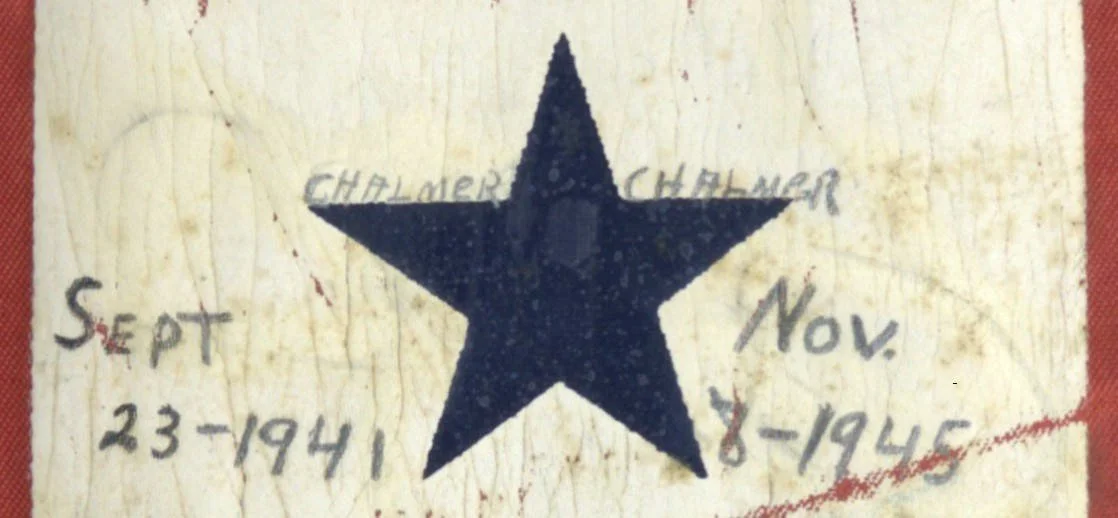Tobias Family WWII Service Flag | Honors the Service of Elkhart, Indiana Brothers Dave, Chalmer, and Chick | Circa 1939-1947
Tobias Family WWII Service Flag | Honors the Service of Elkhart, Indiana Brothers Dave, Chalmer, and Chick | Circa 1939-1947
Frame Size (H x W): 18” x 15”
Service Flag Size (H x W): 11” x 8”
Offered is a service flag created by the Tobias family to honor the military service of three brothers—Ralph Dave Tobias, Chalmer Tobias, and Charles "Chick" Tobias—who served in the United States Army during World War II. The flag features three blue stars on a white field bordered by red, with each star symbolizing one of the brothers’ active military service. This banner, a common form of recognition for families with members in the Armed Forces during wartime, includes handwritten annotations in pencil, providing a record of each brother's service dates. This personal touch transforms the flag from a symbol into a family artifact, capturing a narrative of patriotism and sacrifice.
The inscriptions on the flag indicate when each brother entered and exited military service. Ralph Dave Tobias, the eldest of the three, enlisted on December 31st, 1940, at Fort Benjamin Harrison in Indiana. Born in 1918 and residing in Elkhart, Indiana, Ralph joined the Army Air Corps, a branch of the U.S. Army responsible for aerial combat and support operations during the war. His enlistment at this early date—before the United States officially entered the conflict—reflects his commitment to military service in anticipation of growing global tensions. The date of October 9th, 1945, is marked as his discharge, shortly after the end of World War II in September 1945, suggesting that he served throughout most of the conflict.
The second blue star on the flag represents Chalmer Tobias, born in 1916, who enlisted on September 23rd, 1941, also at Fort Benjamin Harrison. Chalmer’s enlistment took place several months before the attack on Pearl Harbor, highlighting the Tobias family's early involvement in the war effort. Serving as a private in a general service branch, Chalmer’s duties were likely varied, possibly fulfilling essential support roles for the military. His discharge date is recorded as November 8th, 1945, indicating that he, like Ralph, served through the war’s conclusion. Chalmer's service in the Army reflects the widespread mobilization of American families, many of whom contributed multiple members to the cause.
The third blue star represents Charles “Chick” Tobias, the youngest of the three, who enlisted later in the war on July 28th, 1944, at Indianapolis, Indiana. Born in 1921, Charles had less formal education than his brothers, having completed only grammar school, and his civilian occupation was listed as semi-skilled. His branch assignment is unspecified, indicating that he may have served in a versatile role, assisting where needed as the war intensified. The inscription on the flag shows his discharge date as June 30th, 1945, suggesting that he served during some of the most critical periods of the war, likely supporting final operations and demobilization efforts as Allied forces advanced towards victory.
In addition to these dates, the flag includes references to “China” and “Russia,” which may indicate theaters of operation or areas of strategic focus for one or more of the brothers. These inscriptions provide a glimpse into the specific experiences and potential assignments of the Tobias brothers, as the China-Burma-India theater and Soviet-American relations were crucial aspects of the Allied efforts during World War II. The inclusion of these locations on the flag adds depth to the story, suggesting the brothers’ possible contributions to significant international operations, even though their exact roles remain unclear.
A final date on the flag, June 30th, 1947, appears to signify the family’s formal dedication of the banner, potentially marking the completion of their collective wartime experience and the safe return of all three brothers. This post-war date likely reflects a moment of relief and commemoration for the Tobias family, capturing their pride in the brothers' service and gratitude for their survival. By preserving this flag and documenting each brother’s service timeline, the Tobias family created a lasting tribute that reflects both their personal history and the broader narrative of American involvement in World War II.
This flag is emblematic of the sacrifices made by American families during the war, particularly those who sent multiple members to serve. The Tobias family's careful documentation of each brother’s entry and exit from service and the additional geographic references exemplify the attention and pride with which many families approached these symbols. More than a generic service flag, this banner serves as a historical record, encapsulating the individual contributions and the collective commitment of one family to the war effort.
Conservation Process: This flag was hand sewn to cotton fabric, and both were hand sewn to a mounting board. To prevent the black dye in the cotton fabric from seeping into the flag, it was first washed in a standard wash and then in a dye setting wash. The flag is positioned behind Optium Museum Acrylic.
Frame: The frame is made of walnut and dates from 1860 to 1890. Its dark wood and simple craftsmanship reflect the style of the period.
Condition: The flag shows signs of age, with visible staining on the white field and in the bottom corner of the red border. Despite these marks, the flag remains well-preserved, with the pencil inscriptions adding a unique historical interest.
Collectability Level: The Great – Perfect for Rising Collectors
Date of Origin: 1939-1947 (i.e., the former corresponding to the earliest date of manufacture, the latter corresponding to the date of the inscriptions)









